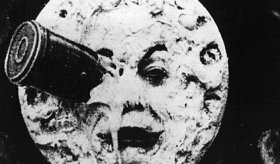|
|
| Tookey's Review |
|
| Pro Reviews |
|
| Mixed Reviews |
|
| Anti Reviews |
|
| Cast |
|
| |
 |
| |
| Released: |
1902 |
| |
|
| Genre: |
IMPORTANT
SCIENCE FICTION
FOREIGN
SILENT
|
| |
|
| Origin: |
France |
| |
|
| Colour: |
BW/C |
| |
|
| Length: |
21 |
|
| |
|
| |
|
|
| |
|
|
|
Reviewed by Chris Tookey
|
Astronauts travel to the moon, encounter unfriendly alien life-forms and return to earth.
Often called cinema’s first true director, George Melies certainly deserves to be regarded as the first skilled and imaginative exponent of cinematic special effects and science fiction. He was born on December 8th 1861. In 1881 he purchased a magic theatre in Paris to pursue his interest in conjuring and illusion. After attending an exhibition of the Lumiere brothers’ new cinematographic equipment, he got hold of a camera and began experimenting with it. By accident (when the camera jammed and images jumped in and out of view) he discovered stop-motion photography.
In 1896, his film The Vanishing Lady used double exposure to turn a woman into a skeleton. In 1897, he built Europe’s first film studio and over the next few years he invented the dissolve, multiple exposure and split screen. He even pioneered colour, through the hand-painting of cells.
His masterpiece is generally considered to be A Trip to the Moon, which Melies wrote, directed and starred in. (He also designed the costumes, built the sets and painted them.) It combined live action with models and stop-motion photography.
Not surprisingly, it is very primitive in technique. Melies never moves the camera, and many of the images are quite jumpy. The acting is laughable at times - the actors form tableaux and posture rather than do anything very naturalistic. The story-telling also leaves plenty to be desired. Without a voice-over, it’s often hard to tell exactly what’s happening, or why. But it has a great deal of charm, and does contain several of the most memorable images in early cinema - especially the rocket built by the astronauts crashing into the moon’s eye.
Melies made hundreds of other films, including several more that owed a debt to Jules Verne and H.G.Wells. In 1912, he became disillusioned with film-making and resumed his stage career, with little artistic or financial success. By 1923, he was bankrupt; but in 1928 some of his work was rediscovered and in 1933 the French government honoured him with the Legion D’Honneur. He died in 1938.
The importance of Melies work, and this film in particular, was that it showed the possibilities of cinema as a fictional, fantastical medium. He was not alone in realising this, but he was among the first to explore the new medium and create reasonably lengthy stories, using state-of-the-art special effects.
Martin Scorsese paid tribute to Melies in his 2011 film Hugo, in which Scorsese restaged several key scenes from Melies’ films.
|
|
|
